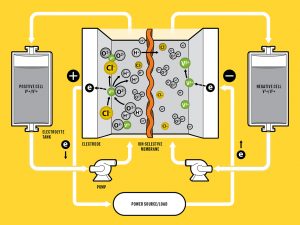Three Battery Innovations to Follow in 2018
January 3, 2018Batteries have an odd reputation. Some of them are famous for exploding. Consumers often associate

them with little, tough pink bunnies. You can even find curated lists of battery memes.
Nonetheless, batteries are a serious business. Since the clean energy pop of the early 2000s, battery research has been a priority for technology and structural development. Recent crises—including Hurricane Irma’s damage in Puerto Rico—have escalated that priority. These emergencies have revealed a future where success may not depend just on capital, but on access to power and energy, especially through stored sources.
Popular figures have begun to put battery advances in the news. The Tesla battery system changed that electric vehicles has been applied as a solar and industrial power solution. Silicon Valley investors have renewed funding for novel battery ventures. Universities and other institutions have also turned their attention to battery research, including investigating rapid charging and plant-based fuel cells.
Here is a list of the top three power supply and battery innovations that could change the way we energize our world.
Alkaline Solid-State Battery
This research has made the furthest advancements under the leadership of Billy Joy, a Silicon Valley legend, at Ionic Materials. He calls his battery the “Jesus Battery.” Invented by Michael Zimmerman, the battery holds promise for several reasons: safety, efficiency and sustainability.
Historically, consumers have relied on two kinds of batteries. Alkaline batteries, like those that don’t come included with toys, use zinc and manganese dioxide. However, they are not rechargeable, which is why electronics turned to lithium ion batteries (Li-ion). A traditional Li-ion battery, like what powers cell phones and electric vehicles, uses a liquid lithium electrolyte solution that carries ions. However, Li-ion batteries can be unsafe. They can catch fire, especially if the liquid gets corrupted with another substance that creates a chemical reaction.
In a solid-state battery, the liquid is replaced with a plastic. In Billy Joy’s case, the polymer is made of alkaline materials, which are far more abundant than lithium and cheaper to source and use. The polymer is naturally flame retardant, an important quality, and the Jesus batteries are rechargeable. They have the potential to be reformatted as large batteries for grid storage due to their efficiency. Drawbacks to this technology include weight/density issues and inadequate cycle amounts. However, with ongoing refinement, Billy Joy anticipates these batteries hitting the industrial market in two to three years.
Sodium Solid State Battery
In Switzerland, a coalition of scientists devised an all-solid-state, sodium-based battery. Their battery has faster charging with an increased storage capacity and improved safety. Besides using sodium as the solid electrolyte, their material choices for other essential battery parts inhibit dendrite formation. Dendrites are electrolytic growths, looking like chemical vines, that cut battery lifespans short. The Swiss team also used a boron-based substance that would conduct the sodium ions. As an inorganic material, it will not catch fire while charging.
Experiments remain ongoing as current prototypes can only withstand 3V and lose 15% of their functional capacity after 250 charge-discharge cycles. Market standards demand 1200 cycles before a battery is a viable product. Researchers are optimistic, however, and remain hopeful that such a cheap and safe solution will provide an answer to battery storage questions.
Redox Flow Batteries
While the two previous innovations could appear in consumer homes in the future, vanadium redox-flow batteries (VRFBs) have already begun to improve grid and large-scale energy storage. This form of battery was invented decades ago, but was only recently adopted as a viable option to lead the industrial battery charge.
VRFBs are appropriate for grid-scale usage, which means they store hundreds of megawatt-hours. For example, a wind farm or solar farm may use a VRFB to capture the excess energy created by these renewable energy sources during peak production times. When the wind dies down and the sun goes away—or demand for energy exceeds even peak production—energy stored on these batteries can be used.
The benefits of VRFBs compared to Li-on power cells are durability, scalability at lower cost, and power supply duration times. Researchers found that industrial Li-on batteries at grid-scale failed after two hours or less. Like alkaline batteries, VRFBs are safer, especially when built around non-flammable materials. Vanadium-based redox-flow batteries also incur lower costs due to higher abundance of vanadium.
Z Gary Yang, a lead developer on this technology, explains their mechanism of power storage and discharge is safer as well: “RFB works more like a reversible fuel cell: To discharge, the battery takes the chemical energy stored in liquid electrolytes and converts it into electrical current, reversing the process to charge.” Other battery forms rely on charged electrodes, increasing fire risk.